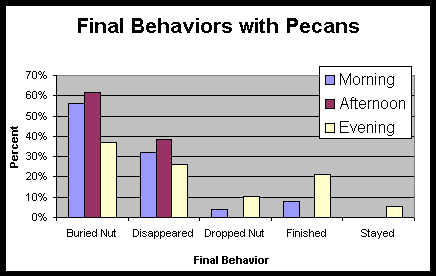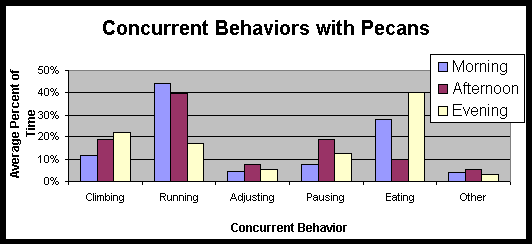Food Handling Behavior:
A Study of Pecan Handling Time in the Eastern Gray Squirrel (Sciurus carolinensis)
By
Andrew G. Watts
Abstract: The eastern gray squirrel (Sciurus carolinensis) is a useful tool for studying animal behavior. The main objective in this study is to determine the differences in pecan handling time during three parts of the day. It is plausible to assume that squirrels may eat less during the middle of the day than in other parts of the day. Pecans collected in the previous autumn were tossed to squirrels at different parts of the day and the behaviors were noted and observed. A chi-square test showed that there is a significant correlation between handling behavior and time of day. To better understand the behavioral ecology of the gray squirrel, further study would be necessary.
Keywords: Sciurus, squirrels, caching, nuts, activity, behavior, pecans, handling
Introduction
For a long time, the eastern gray squirrel (Sciurus carolinensis) has been an important research tool for the study of animal behavior (Spritzer 1999). The gray squirrel is found in several habitats across the eastern United States, such as temperate forests, neighborhoods, city parks, and college campuses. Over the past two centuries these mammals have been introduced to England, South Africa, parts of the western United States, and parts of Italy (Currado 1998, Hartson 1999).
Time of year may be a factor in the food handling time of gray squirrels. The average time a squirrel takes to locate, pick up, and carry a pine cone is lowest in June when it is hot (Gurnell 1987). Similarly, studies can be conducted to determine if nut-handling behavior is lowest during midday, the warmest part of the day. The purpose of this experiment is to observe pecan-handling behavior in gray squirrels by comparing their activities among three parts of the day. I speculate that squirrels will bury the pecans most often in the evening. This is most likely because they may have already used a large portion of their energy to handle food and because pecans generally have a high handling time. I also predict that squirrels may eat less during the middle of the day due to general inactivity brought on by the heat. Similar studies on food handling behavior have been conducted on Abertís squirrels (S. aberti) in Arizona (Keith 1964).
Methods
The study area for my experiment was the Reitz Union lawn on the campus of the University of Florida, Gainesville, Florida. It contains trees such as hackberry, palm, magnolia, pecan, oak, pine, and others. Gray squirrels are frequently encountered here, and are therefore easy to observe. The pecan feedings took place on Saturdays, Sundays, and other days when there was minimal human activity. The behavior of squirrels will be different if there are too many people moving through the study area.
The study was conducted during March and April of 2001. In the previous autumn, I collected pecans that came from pecan trees at what is now my study area. I tossed pecans to different squirrels at three different parts of the day (morning [n = 25], midday [n = 13], and evening [n = 19]) for several days. The behaviors of each squirrel that picked one up were recorded. I also recorded how long it took for each squirrel to finish eating a pecan, if they did at all. The concurrent behaviors squirrels exhibited with the pecans were timed (running, climbing, adjusting the nut, etc.). Running included activities such as looking for a place to bury the pecan. Final behaviors (burying the nut, dropping the nut, disappearing, etc.) were recorded but not timed. The time a squirrel takes to bury a pecan is relatively constant (10-15 seconds), so it is not measured as a concurrent behavior. The instant the squirrel finishes patting down the soil is recorded as a final behavior. Concurrent and final behaviors were analyzed between different parts of the day. I used binoculars to observe squirrels that moved high in the trees. To compare concurrent behaviors, a chi-square test was used comparing lengths of time.
Results
There was considerable variation in behavior among the squirrels during different time intervals. Figure 1 shows that during the middle of the day, squirrels buried pecans more often than in other parts of the day (mean = 62% of midday final behaviors). They also disappeared from site proportionately more often during midday (mean = 38% of midday final behaviors). Instances where squirrels dropped the pecan without finishing occurred mainly in the evening (mean = 11% of evening final behaviors). The greatest percentage of pecans that squirrels finished eating also occurred in the evening (mean = 21% of evening final behaviors).
Figure 2 shows that squirrels tend to eat pecans most often in the evening (mean = 40% of evening concurrent behaviors) and least in the afternoon (mean = 10% of afternoon concurrent behaviors). Much adjusting (mean = 7%) and pausing (mean = 19%) occurred in the afternoon. The occurrence of running was greatest during the morning (mean = 44% of morning concurrent behaviors).
I have conducted a chi-square test comparing concurrent behaviors of gray squirrels handling pecans between morning (n = 25), midday (n = 13), and evening (n = 19). The relatively small amount of squirrel activity during midday, which was consistent for several days of sampling, accounts for its low sample size.
Discussion
There is a significant correlation between pecan handling behavior and time of day. However, my speculation that squirrels bury pecans more often in the evening was refuted. Possible sources of error may be related to weather conditions such as cloudiness or wind. Wind often causes inactivity in squirrels due to difficulties of moving about (Gurnell 1987). Nonetheless, squirrels do not eat pecans as often in the midday as they do in other parts of the day due to general inactivity as predicted. Additionally, squirrels pause more while handling a pecan during in the middle of the day than in the other parts of the day, indicating lessened activity. Findings suggest that squirrels tend to eat pecans most in the evening.
Temperature indeed influences activity in the gray squirrel. Usually the warmer the temperature, the less likely squirrels will be active. However, pecan burying is an activity, and it was observed mainly during the middle of the day. Another prediction would be that burying a pecan is less energetically expensive than eating one, especially when the surrounding temperature is hot.
In conclusion, additional studies must be conducted on food handling time for the gray squirrel as a means of properly understanding their ecology.
Literature Cited
Currado, Italo. The Gray Squirrel (Sciurus carolinensis Gmelin) in Italy: A Potential Problem for the Entire European Continent. In M. A. Steele, J. F. Merritt, and D. A. Zegers (eds.). 1998. Ecology and Evolutionary Biology of Tree Squirrels. Special Publication, Virginia Museum of Natural History, 6: 320 pp.
Gurnell, John. 1987. The Natural History of Squirrels. Facts on File Publications, New York.
Hartson, Tamara. 1999. Squirrels of the West. Lone Pine Publishing, Renton, WA.
Keith, James O. 1964. The Abert Squirrel and Its Dependence on Ponderosa Pine. Ecology 46:150-163.
Spritzer, Mark D. 1999. Gray Squirrels (Sciurus carolinensis) in Florida: Microgeographic Genetic Structure, caching behavior, ranging patters, and resource use. Masterís Thesis. University of Florida.

Fig. 1. Percent of occurrences for each final behavior. Each bar represents the percent of final behaviors for the average day.

Fig. 2. Concurrent behaviors of squirrels with pecans. Each bar represents the average percent of time squirrels exhibited each behavior at each time of day.

